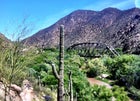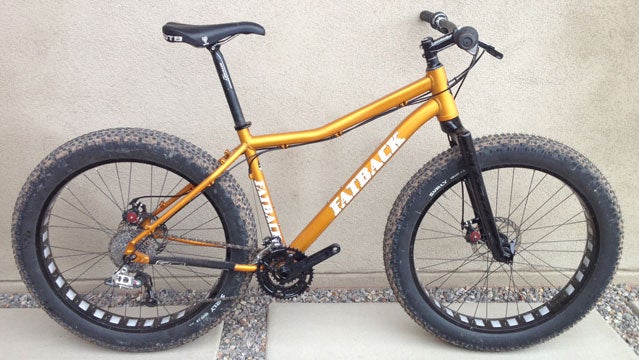The evolution of fat bikes reminds me a little bit of the trajectory of 29ers. They launched among a subset of iconoclasts, established themselves as a niche thanks to some cool traits and riding properties, and then gained wider acceptance as devotees talked them up. Development has mirrored that progression, too, as some of the first fatties I tried were entertaining but had design limitations including excessive weight, toe overlap, and sluggish steering.

Not so with the . Though it was one of the first fat bikes out there (pre-empted as a production bike only by the original ), these Anchorage, Alaskan-built rigs were crafted for the and other snow races, and are supposed to be lighter, quicker, and nimbler than most fatties.
That was certainly my experience. The stock build came out of the box at a svelte 28 pounds, and just pedaling it around the parking lot on that first ride I knew it was going to be a rocket ship. I’ve been riding it for almost an entire season now, in snow, sand, rocks, and desert singletrack, and that original infatuation hasn’t abated.
THE FRAME
We tested an 18-inch aluminum bike, which came in a rusty orange color with a gorgeous and tough bead-blasted finish. The first thing I noticed was just how light the bike really is: Frame weight is under four pounds, aided in part by the house-made rigid carbon fork. It may be alloy, but the Fatback is equipped with all the modern fixings, including an oversize tapered headtube, outboard bearing bottom bracket, direct-mount front derailleur, and post mounts for both front and rear brakes. There are plenty of nice little touches, too, such as the neat cable routings throughout, rear rack mounts, and three bottle braze-ons, including one underneath the down tube (plus plenty of clearance) for carrying a bottle at the same time as a frame pack.
The geometry is a little bit surprising, with longish chainstays and top tube, but it works once you climb aboard. The more stretched-out position feels like it’s made for going fast, and you have the sensation of being aboard a hardtail race 29er, not a fat bike. Best of all, the very low top tube yields tons of stand-over, which is great for throwing the bike around and maneuvering but is just as useful for top tube-mounted packs and bags for long-distance hauling capacity.
Geometry numbers are one thing, but you don’t get the Fatback’s full effect until you take it out on a trail. My first ride was on dry, fast, rubbly singletrack, and I was amazed how nimble the bike felt. Steering is quick for such an oversized rig and surprisingly accurate given the fully rigid front end. In spite of the big wheels and longer rear end, even the acceleration felt good. I was riding with a small group of locals aboard lightweight hardtails with racing tires, and I never felt pressed to keep up. I’ve subsequently ridden the Fatback in sand, mud, and lots of snow, and the lively feeling, which I feared might be a bit too quick for snow riding, felt just fine.
THE PARTS
Other than the rigid carbon fork, the standout parts on this bike are the wheels. With perforated 70mm rims strung to house-branded Hadley hubs, these wheels are feathery light given the float they provide. I first rode them with a set of , arguably the best fat tire on the market for their combination of sticky rubber, grippy shoulder knobs, and fast-rolling center. After that, I rode the slightly skinnier 3.8-inch , which are speedy for hardpack snow and drier trails but a bit too smooth for fresh snow. Coming down the Santa Fe ski hill in eight inches of fresh powder, I had marginal control and several visions (though no calamities) of ending up in a tree well. Also worth noting, Fatback’s experience with Alaskan racing means that the grease and bearings in these hubs are equipped to run smoothly to minus 30 degrees and below.
Everything on the Fatback is about durability and practicality, including the , which Fatback says are less likely than hydraulic brakes to fail in the cold, and the SRAM nine-speed drivetrain. I’ve never been a huge fan of but have to admit that it worked just fine here and proved much easier to operate with thick gloves and frigid hands than the standard thumb shifters. As for the rest of the bits, it’s all quality, with Ritchey carbon seatpost and bars, and an unexpectedly comfortable .
THE BOTTOM LINE
The idea of a “race” fat bike might seem contrary to the methodical, plodding sensibility of big wheels, but having spent so long on the Fatback, it’s probably the only style I’ll ride in the future. Trundling through snow takes a lot of effort, and this bike’s weight makes a huge difference. It’s not the only racer fatty out there, but it is the quickest, most fun bike we’ve tried in this genre. (The recently launched , which I haven’t yet tried, should provide some competition.) The Fatback is no anemic ride, either, as we bashed it down sandy arroyos, over chunky rock gardens, and through piles and piles of snow, and it never once faltered.
That versatility is perhaps the best part about the Fatback. Sure it rides great in the snow, but it’s also at home on tight trails and grinding fire road climbs—even with the fat wheels. Ours came with a second pair of 29er wheels (sold separately for $600), and when we mounted them up, the bike felt just as sprightly as any other hardtail. In that sense, the Fatback is a bargain at $3,400, as it can double as a summer and winter ride. And the , which mates the same frame to slightly less expensive components, is a real steal. This is a fat bike that serves elite-level racers as well as the average rider looking for an easy one-stop option for riding both dirt and snow.
It’s so entertaining that even now, as the snow has melted out, I find myself reaching for it above most of the other bikes in my garage and returning from my trail rides on our local singletrack as satisfied as ever. Put away the skis and snowshoes—but not the Fatback.


